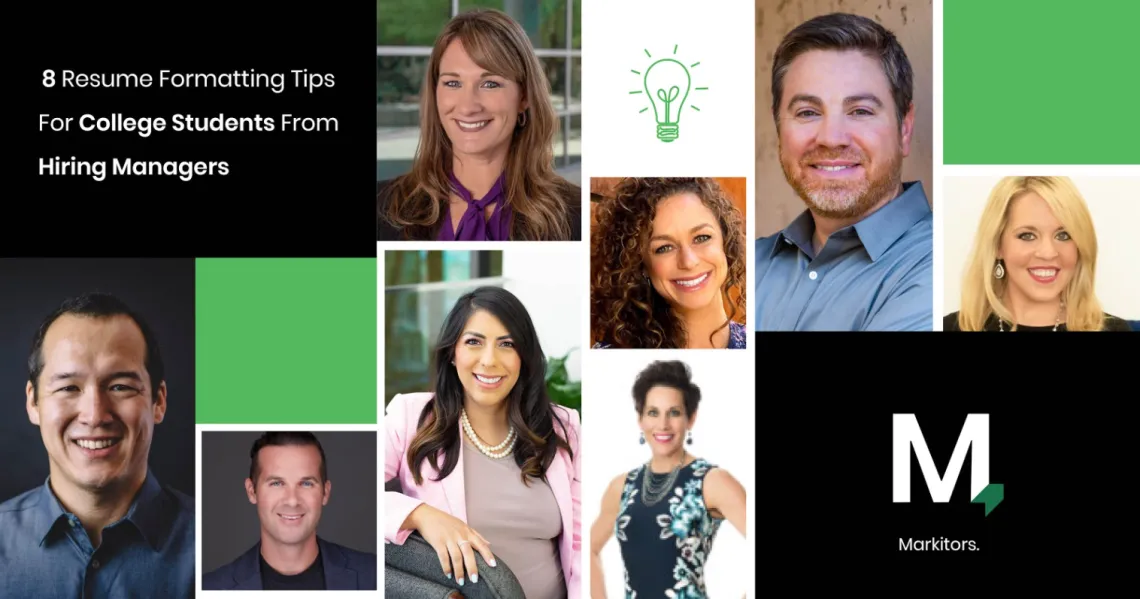Eight Resume Formatting Tips For College Students From Hiring Managers

A resume is so much more than a summary of work experience—it is the narrative that is pitched to a potential employer! In order to really stand out, a resume should tell a story of why you are the best candidate for this position. Unfortunately, no matter how great the story is, if it is not well organized and formatted, then recruiters will simply toss it to the side.
When crafting a resume, it can be hard to tell if it’s organized in a way that is eye-catching and easy to read. That is why we collected eight tips from hiring managers across the country on how to best format a resume!
Tailor the Resume to Connect Directly to the Job Description
One resume formatting tip I always suggest to students is to take time to tailor the resume to make direct connections to the job description for each and every application. This may seem time consuming, but recruiters and hiring managers often take about six seconds to review a resume. (Scary, huh?) If they do not see something that connects directly to the job description, they might just move on to the next candidate. A great resource is a tool called Jobscan. You can complete five free scans at Jobscan! Your resume is one of the most important documents to showcase your unique and marketable skills, both technical and interpersonal. Take the time to make an impression!
Melissa Poole, Associate Director, MBA Professional Development and Career Coach at the Eller College of Management
Don't Forget the Fun Fact
Three resume formatting tips:
-
Make it one page
-
Write a summary of yourself to include your personality type, career goals and achievements at the top of the page to get the recruiter excited.
-
Add a fun fact about yourself. If it makes them laugh you have won serious brownie points.
Stephanie Feder, ‘09 BA (Regional Development), Vice President of Business Development at Qwick
Optimize Your Readability
It may seem too simple to be important, but this can make or break a recruiter’s decision to pass a resume along. Choose an easy to read, professional font that is not too small and not too big. Font sizes between 10 and 12 are usually the best choice. Stick to only using black font; making the resume colorful will only make it more difficult to read and will be skipped over. Also, ensure that the spacing is even throughout the resume to help with readability. These three simple tips are crucial in making a resume professional and it is shocking to see how often one or more of these are ignored by candidates.
Jennifer Schissel ‘08 BSBA (Accounting), Director of Finance and People at Y Scouts
Be Concise
There is limited time to make an impression on someone simply from a resume. Focus on your greatest accomplishments and show actionable results whenever possible. This will help you stand out and show employers that you understand the impact of your work and how you can make a difference.
Elyse Flynn Meyer ’07 BSBA (Marketing and International Business), President and Founder of Prism Global Marketing Solutions
Use a Personal Domain
Rather than use a free email address on a resume, step it up and create an email account using a personal domain. Register the domain and set up an email and a one-page website. A custom email address shows technical savviness and initiative.
Brian Greenberg ’00 BSBA (Entrepreneurship, Marketing), CEO and Founder of True Blue Life Insurance
Utilize LinkedIn to Fill in the Gaps
Focus on the most important stuff, and tailor the resume for the recipient. You don't need to list all of your capabilities or all of your experience—just what's the most relevant to the job you're applying to. LinkedIn serves as a nice way to fill in the gaps if it comes to that part of the vetting process.
Joshua Schlag ’05 BS (Computer Science) ’11 MBA, Digital Marketing Manager at Pyramid Analytics
Share Interests
I print and save the resume of every employee I’ve ever hired. In looking back at the resumes of the employees who have succeeded at our company, I find that the commonality of each one communicates unique “interests” that align well with our company. For example, one of our employees listed “long distance running” as an interest, which aligns well with the marathon that is “search engine optimization.” Too many candidates don’t share their interests, which is a missed opportunity because resumes do such a poor job of capturing who a candidate really is. List your interests, and include ones that you feel would be relevant at the company.
Brett Farmiloe ‘06 BSBA (Accounting), CEO and Founder of Markitors
Consider the Industry You’re Applying For
If you’re a creative applying to creative positions, such as graphic design, advertising or marketing, make sure the resume reflects that by using color or graphics. There is more flexibility in the format of a resume in creative fields because it is another opportunity to showcase skills. For other industries that are more traditional or require certifications or licenses, prioritize those higher on the resume and use a clean, black and white scheme. There is no universal resume format rule other than making it the best it can be.
Kristy Bach ‘87 BS (Marketing), COO of BestCompaniesAZ

